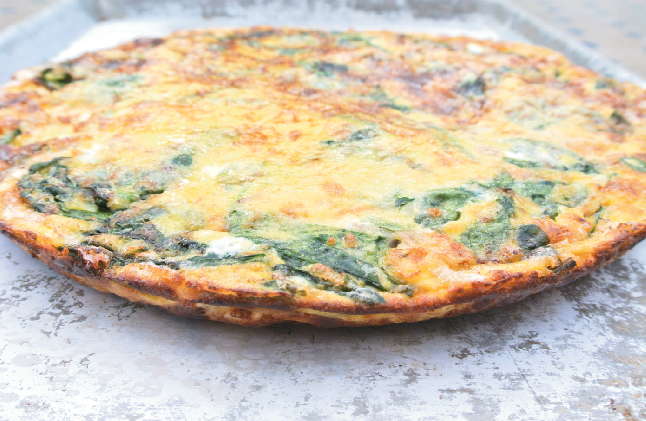When we were growing up, my mother tried to convince my sister and me that a frittata was a good use of leftover spaghetti. At the time, we would have nothing to do with it. The idea of eggs mixed in with yesterday’s leftovers made my skin crawl.
Now, as an adult some forty years later, I crank out frittatas all the time and as I cook them, I realize how a simple formula can be adapted into many different tastes and flavors. Leftover spaghetti included!
This article is more of a cooking lesson than a specific recipe. The beauty of frittatas is you can make a well-planned meal for breakfast, lunch or dinner, or go rummaging through your fridge or pantry to make a frittata. And the odd beauty of this dish is that no frittata will come out the same way twice. Every one is different.
Special Equipment
There are only two pieces of equipment you need for a frittata: a “healthy” non-stick skillet and an oven with a broiler. I say “healthy” because if you have one of those all-scratched up non-stick pans that can no longer cook an egg, dump it and head to Bed, Bath and Beyond or Target and get a $40 BIG non-stick skillet. These pans will not last forever so don’t spend a fortune on a pan. However make sure you get one with an oven-safe handle since you’ll be exposing it to very high oven temps under the broiler.
The basic egg recipe – the “glue” if you will
•12 eggs
•Some milk or heavy whipping cream; perhaps 1/2 cup milk or 1/4 cup heavy whipping cream
•Salt, pepper and maybe a quick shake of cayenne pepper to taste
Place all these ingredients into a large bowl and vigorously whisk until combined. This quantity can make enough for 6 dinner-sized servings or you can cut into 16 slivers as an appetizer or for use when making a bunch of different frittatas.
Now the fun part – the contents of the frittata
You will want to pick items that have a natural affinity for each other. Think of things that you might find on a plate together anyway, or on a pizza: a frittata can also be a vehicle for serving them. And cheese is a key ingredient in any frittata. While not mandatory, a cheese will really enhance the egg taste. The idea with contents is to prepare them, then let them cool, then add them to the egg mixture you just made.
Here are some ideas:
•1 pound of asparagus, ends trimmed and cut into 1/2 inch pieces and sauteed until soft, 2 diced tomatoes and 4 ounces of diced or shredded Fontina cheese
•A bag of cleaned spinach cooked a bit in a skillet with olive oil, salt and pepper to wilt, 1/4 pound sliced Prosciutto, some grated Parmesan cheese and some shredded Mozzarella cheese
•One package of quartered artichoke hearts (purchased frozen and then defrosted) fried in a little olive oil, sliced mushrooms sauteed in olive oil, salt and pepper and some cheese
The technique
Place your non-stick skillet on the stove over medium heat. Turn on your broiler.
Add a bit of olive oil (2 tablespoons) and heat the pan with the oil until the whole thing is the temperature of the medium heat flame.
After letting the frittata contents come to room temperature, add it to the egg mixture and gently stir until you have a homogenous mixture. Add a little more salt and pepper. If you’re not afraid of raw eggs, taste the mixture and season with more salt and pepper as you like. Other herbs like basil, dill, oregano and mint are great with frittatas.
Add the egg mixture to the heated pan. Generally, you should NOT hear a sizzle at this point. If you do, turn down the heat further to medium-low.
Slowly cook the frittata until the edges start to firm up. Use a silicon spatula to loosen the edge of the frittata from the pan. Inspect the bottom of the frittata as you do this to make sure it’s not browning too much.
When the frittata is cooked about 3/4s of the way from the bottom of the pan, move it to the heated broiler. Set the frittata about 6-inches below the broiler.
Now this is the hard part. Closely watch the frittata until it’s lightly browned but not over-cooked or burnt. You can burn a frittata in seconds so you REALLY need to watch this closely. When it is just golden brown and puffed up, remove the skillet to your stove top. BE SURE TO PROTECT THE HOT HANDLE WITH A HOT PAD!
Let the frittata stand for 5 to 10 minutes to allow it to firm up. Slide it out to a cutting board and slice up like a pizza in portions as you desire.
Serve with items like a dressed green salad and toasted bread with a smear of ricotta and jam.
Notes: Don’t cut the frittata in the skillet as you’ll scratch the non-stick skillet. Also, if making frittatas for the next day, place on a sheet pan, cool completely and cover with aluminum foil and place in the frig. On the next day, let come to room temperature and place in a 350 degree oven for 10 minutes. Slice and serve.
Joe and Michele Becci are a brother and sister team who love all things Italian. Together, from opposite coasts, they co-author the blog OurItalianTable.com.






























